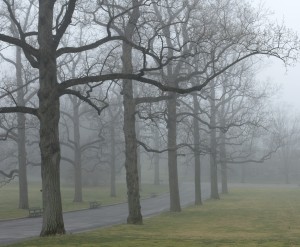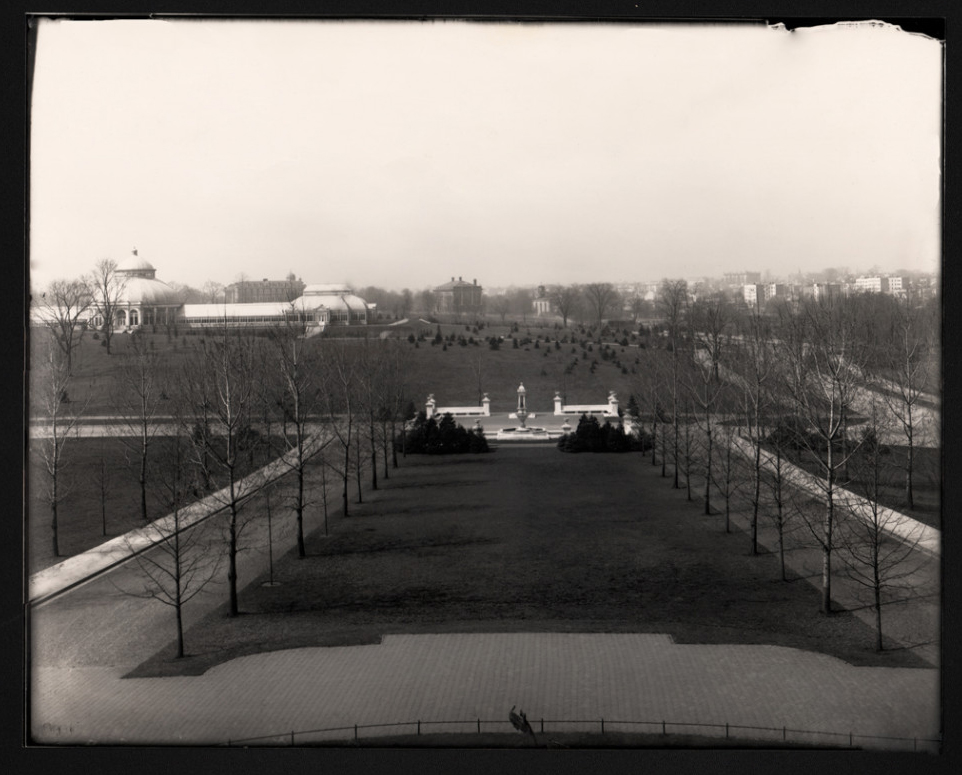Giants of the Allée
Posted in Around the Garden on December 12 2011, by Matt Newman
 The barren branches that fill the sky come winter are a sore sight for some, but if you look at a naked tree in just the right way, there’s more beauty there than you might at first believe. Of course, not everyone needs a special angle to see that–I think bare trees are almost more fascinating than their spring and summer alter egos. Such complex geometry to be seen once the foliage falls away! And no place in the Garden exemplifies this kind of beauty quite like Tulip Tree Allée.
The barren branches that fill the sky come winter are a sore sight for some, but if you look at a naked tree in just the right way, there’s more beauty there than you might at first believe. Of course, not everyone needs a special angle to see that–I think bare trees are almost more fascinating than their spring and summer alter egos. Such complex geometry to be seen once the foliage falls away! And no place in the Garden exemplifies this kind of beauty quite like Tulip Tree Allée.
Maybe it’s the perfect arrangement of these trees on either side of the pathway that makes them so interesting, or perhaps it’s more likely that the bizarre arcs and angles of the branches themselves hold my attention. They sweep and dip in all directions while their budding twigs have a penchant for reaching straight up. And so large are these tulip trees that it sometimes seems there isn’t an inch of sky without the lattice of their skeletal lines. The contrast with fall’s whitewashed sky is striking if you just sit on a nearby bench and look up.
As histories go, these trees are some of The New York Botanical Garden’s longer-lived residents, planted by none other than the person who established the NYBG in the first place–Nathaniel Lord Britton. The Library Building (then known as the museum) was completed in 1901, and there was a need for an accent that would lead the eye up the main approach to its future centerpiece. Britton settled on poplars in 1903, the same year ground was broken for the Lillian Goldman Fountain of Life.

By the fountain’s completion in 1905, the poplars seemed to have proven contrary to the Director’s vision, and Britton opted to plant tulip trees in between each one. The poplars lasted just six more years before being removed, leaving only the young tulip trees to flank the Allée by 1911–since then they’ve grown to dominate the space. And seeing as the tulip tree (Liriodendron tulipifera) is the tallest of the eastern hardwoods in North America, “dominate” really is the proper verb in this situation. These towering trees can grow up to 190 feet in height, with a trunk circumference of between 24 and 30 feet at their largest, and broad orange flowers reminiscent of the breed’s close relative, the magnolia.
Over the decades, the tulip trees have grown to add just the kind of grandeur I imagine Mr. Britton had always foreseen, though I’m willing to bet they still have a few more feet in them yet.


Dear Matt,
In 2003 I built a 60 meter poplar allee but am thinking of replanting it with tulip trees. How far apart should I plant the tulip trees, 30ft, 45ft or 60ft? Thank you for your feedback, Joaquim Luiz Gomes, Portugal